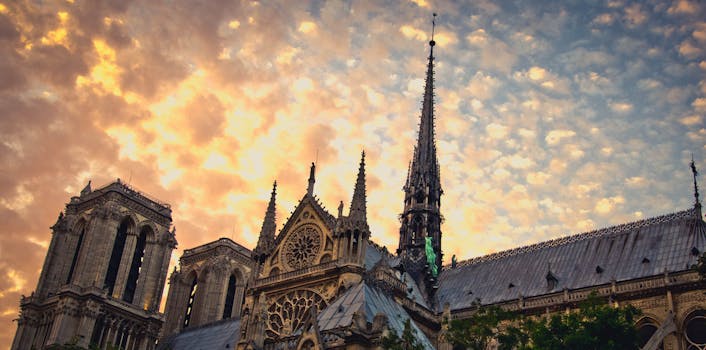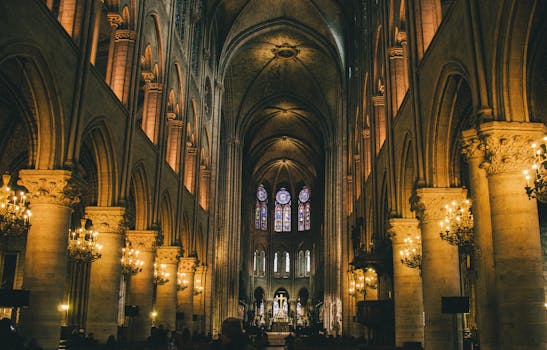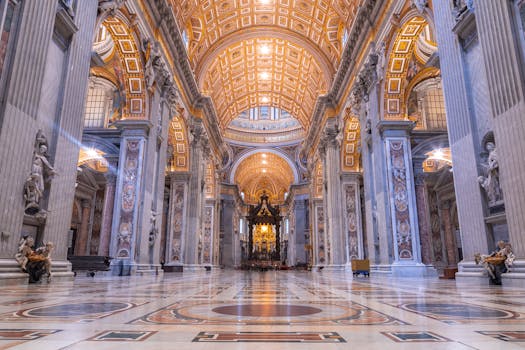Cathedrals are more than just religious buildings—they are cultural, architectural, and historical icons that attract millions of tourists each year. These grand structures, often situated at the heart of cities, provide a window into the past, showcasing the craftsmanship and devotion of the eras in which they were built. Whether it’s their towering spires, intricate stained glass, or historical significance, tourist attraction cathedrals remain some of the most visited landmarks worldwide.
Cathedrals offer an immersive experience into different historical periods, giving visitors a unique insight into the spiritual and artistic sensibilities of the time. Their towering presence in urban landscapes often defines the cities they stand in, and their appeal goes far beyond religious significance.
Historical Importance of Cathedrals
During the medieval period, cathedrals played a vital role in both the religious and social lives of the communities they served. These structures were often the center of local life, hosting not only religious services but also important social and economic activities. Cathedrals were a statement of power and devotion, constructed to last centuries and demonstrate the wealth of the church and the rulers who commissioned them.
In many European cities, the construction of a cathedral was a communal effort that spanned generations, signifying the importance these structures had for entire communities. The clergy often played a key role in the governance of the region, and cathedrals became seats of both spiritual and political power. From baptisms to coronations, these buildings have witnessed some of the most significant events in history.
Architectural Marvels
The design of cathedrals is an architectural feat that has evolved over time, reflecting different styles and innovations. Early cathedrals were built in the Romanesque style, characterized by thick walls, rounded arches, and small windows. As time passed, the Gothic style took hold, with its soaring heights, pointed arches, and expansive stained glass windows that flooded interiors with light. Each cathedral tells a story not only of the religious beliefs of its builders but also of the technological advancements and artistic trends of the time.
Gothic architecture, with its flying buttresses and ribbed vaults, allowed for the creation of larger windows and taller structures, a significant departure from the heavy, grounded Romanesque buildings. Cathedrals became a canvas for artistic expression, from intricate carvings and sculptures to the brilliant colors of stained glass windows that depicted religious stories and saints. Visitors today can still marvel at the craftsmanship that went into the construction of these ancient structures.
Famous Cathedrals Around the World
Some of the most famous cathedrals in the world draw millions of visitors each year. These include:
- Notre-Dame de Paris, France: Known for its Gothic architecture and its role in Victor Hugo’s novel, this cathedral is one of the most iconic in the world.
- St. Peter’s Basilica, Vatican City: An architectural masterpiece of the Renaissance, this cathedral stands as the heart of the Catholic Church.
- Sagrada Família, Spain: Antoni Gaudí’s still-unfinished masterpiece in Barcelona is renowned for its unique design.
Each of these cathedrals not only serves as a place of worship but also as a cultural and historical beacon for the surrounding city. Their timeless beauty continues to attract visitors from all over the globe, offering them a chance to experience a piece of the past firsthand.
Gothic Architecture and Its Influence
The Gothic style, which emerged in the 12th century, revolutionized the way cathedrals were built. The use of flying buttresses, ribbed vaults, and pointed arches allowed builders to create taller, lighter buildings with expansive windows. Gothic cathedrals were often decorated with intricate stone carvings and sculptures, illustrating religious themes and stories. This style dominated cathedral construction for several centuries and can be seen in famous buildings like Chartres Cathedral and Cologne Cathedral.
The Gothic style also introduced a sense of verticality and light into cathedrals, intended to draw the viewer’s gaze upwards, toward heaven. The innovations in engineering allowed these massive structures to appear weightless, enhancing their spiritual significance and architectural grandeur.
Baroque and Renaissance Cathedrals
The Baroque and Renaissance periods brought a new level of grandeur and ornamentation to cathedral architecture. Baroque cathedrals, with their dramatic use of light and shadow, ornate details, and grandiose scale, were designed to evoke awe. The St. Paul’s Cathedral in London, for example, showcases the balanced symmetry and classical influences typical of Renaissance architecture, while still incorporating Baroque elements in its dome and decorative features.
The Renaissance focus on harmony, proportion, and geometry brought a more humanistic approach to cathedral design, as seen in Florence’s Duomo. The Baroque era, on the other hand, emphasized movement and drama, with interiors rich in sculptures, gilded decorations, and lavish frescoes, offering visitors a sensory experience that captured the grandeur of the divine.
The Cultural and Religious Role of Cathedrals
Beyond their architectural beauty, cathedrals have always played a significant role in the spiritual lives of those who visit them. They are places of pilgrimage for believers, centers of community activity, and symbols of faith and endurance. Even today, many cathedrals host regular services, festivals, and events that draw not only worshippers but also curious tourists interested in experiencing the living history of these sacred spaces.
Cathedrals are not just relics of the past—they continue to serve as vibrant centers of religious and cultural life. From Christmas services to art exhibitions, they bring together people from all walks of life, offering a sense of continuity and connection with the past.
Tourism and Cathedrals
The presence of cathedrals in popular tourist destinations greatly boosts local economies. Visitors flock to cities like Paris, London, and Rome not just for the cathedrals themselves but for the surrounding businesses—hotels, restaurants, shops—that benefit from the influx of tourists. Cathedral tours are often a highlight of city visits, offering insights into history, culture, and art.
The revenue generated from tourism often helps fund the maintenance and restoration of these historic structures. Many cathedrals now offer guided tours, multilingual audio guides, and interactive exhibits to enhance the visitor experience. This not only preserves the buildings but also enriches the understanding of their significance for modern audiences.
Modern Innovations in Cathedral Design
While many of the world’s most famous cathedrals were built centuries ago, modern innovations have allowed for the construction of new cathedrals that combine traditional elements with contemporary design. One example is the Cathedral of Christ the Light in Oakland, California, which incorporates eco-friendly technologies and modern materials while maintaining the spiritual ambiance typical of older cathedrals.
Today’s architects are finding new ways to balance tradition with innovation, using sustainable materials and technologies to reduce the environmental impact of new cathedrals. This blend of old and new ensures that future generations can continue to experience the wonder of these architectural marvels while embracing modern values of sustainability and environmental responsibility.
Sustainable Tourism in Cathedral Visits
As the popularity of cathedral tourism continues to rise, so does the need for sustainable practices. Preservation efforts are vital to maintaining these ancient structures for future generations. Tourists are encouraged to be mindful of their impact, respecting both the physical integrity of the buildings and the spiritual practices that occur within them.
Simple actions such as donating to restoration funds, avoiding littering, and following guidelines for responsible tourism can make a big difference in preserving cathedrals. Many cathedrals now offer information on how visitors can contribute to conservation efforts, ensuring that these cultural treasures remain intact for future generations.
Exploring Cathedrals in Europe
Europe is home to some of the most breathtaking cathedrals in the world. From the Cologne Cathedral in Germany to Florence’s Duomo in Italy, each structure offers a unique glimpse into the region’s history, culture, and art. A trip through Europe is often not complete without a visit to at least a few of these architectural masterpieces.
These cathedrals are more than just places of worship—they are integral to the identity of the cities they inhabit. Their presence dominates skylines and their histories are intertwined with the stories of kings, emperors, and ordinary citizens alike.
Cathedrals in Latin America
Latin America boasts a number of impressive cathedrals, many of which were built during the colonial period. These cathedrals blend European architectural styles with local influences. The Cathedral of Mexico City, for example, is one of the largest and oldest in the Americas, showcasing a mixture of Baroque, Renaissance, and Neo-Classical styles.
Latin American cathedrals reflect the rich, diverse history of the region, where European settlers, indigenous cultures, and African influences come together to create truly unique architectural styles. These cathedrals are not just relics of colonialism—they are living, breathing testaments to the multicultural heritage of the region.
Asian and African Cathedrals
Though fewer in number, Asia and Africa are home to several noteworthy cathedrals that reflect the spread of Christianity across these continents. St. Andrew’s Cathedral in Singapore and St. George’s Cathedral in Cape Town are prime examples, offering visitors a chance to experience the unique architectural and cultural blend present in these regions.
While the design of these cathedrals often draws from European styles, they also incorporate local traditions and materials, making each structure a reflection of its unique cultural context. Visiting these cathedrals offers a fascinating insight into the ways Christianity has been adapted and expressed in different parts of the world.
Planning Your Visit to a Cathedral
Visiting a cathedral is often a highlight of any trip, but proper planning is essential to ensure a smooth experience. Many cathedrals have specific visiting hours, and some may charge entrance fees. It’s also important to be respectful of ongoing services and ceremonies, which may limit access to certain parts of the building.
Be sure to check whether the cathedral offers guided tours or special exhibits that can enhance your visit. Many cathedrals now offer digital apps or audio guides, providing detailed information on the history and architecture of the building. For the best experience, try to visit during quieter times, avoiding peak tourist hours.
Frequently Asked Questions about Tourist Attraction Cathedrals
What is the most visited cathedral in the world?
St. Peter’s Basilica in Vatican City is often considered the most visited cathedral globally, drawing millions of tourists and pilgrims each year.
Can I attend a service at a cathedral as a tourist?
Yes, many cathedrals welcome tourists to attend services, though it’s important to be respectful of religious practices.
Are cathedral tours available in multiple languages?
Most popular tourist attraction cathedrals offer guided tours in several languages, making it easier for international visitors to learn about their history and significance.
Do I need to dress a certain way when visiting a cathedral?
Modest clothing is usually recommended, especially when visiting active places of worship. In some cathedrals, particularly in more conservative areas, visitors may be asked to cover their shoulders and knees.
How long does it take to visit a cathedral?
The duration varies, but most visits can take between 1-2 hours depending on the size of the cathedral and the available exhibits or guided tours.
Are donations required when visiting a cathedral?
While donations are not usually required, they are often encouraged to help with the upkeep and restoration of these historic buildings.









